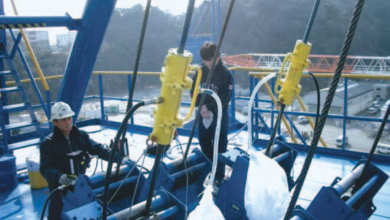DIY Slip Rings and Waterproof Slip Rings: Enhancing Performance and Durability in Electrical Projects

Slip rings play a crucial role in electrical projects by enabling the transmission of power and signals between rotating and stationary parts. When it comes to slip rings, two important options to consider are DIY slip rings and waterproof slip rings. In this article, we will explore the characteristics, construction, and performance considerations of DIY slip rings and waterproof slip rings. We will delve into the advantages they offer in terms of enhancing performance and durability in various electrical projects.
Understanding DIY Slip Rings
DIY slip rings are slip rings that enthusiasts construct themselves. They provide a cost-effective and customizable solution for specific project requirements. DIY slip rings can be constructed using various materials such as brushes, contact blocks, and rotating rings. The construction process involves sourcing the necessary components, assembling them, and ensuring proper electrical connections. DIY slip rings offer flexibility and customization options, allowing enthusiasts to design slip rings with specific numbers of circuits, contact materials, and size. These slip rings are commonly used in hobbyist projects, experimental setups, and small-scale automation.
Understanding Waterproof Slip Rings
Waterproof slip rings, as the name suggests, are slip rings specifically designed to operate reliably in environments where protection against water and other potentially damaging elements is crucial. These slip rings are built with features that prevent water ingress and ensure their durability in wet or harsh conditions. Waterproof slip rings typically incorporate seals, gaskets, or special coatings that protect the electrical connections from water and moisture. They are commonly used in outdoor installations, marine applications, underwater robotics, and any project where exposure to water or moisture is a concern. Waterproof slip rings provide robust protection against environmental elements, ensuring the longevity and reliability of electrical connections.
DIY Slip Rings: Construction and Performance Considerations
The construction of DIY slip rings involves assembling various components into a functional unit. The choice of materials, such as the type of brushes and contact blocks, can significantly impact the performance of DIY slip rings. Ensuring proper alignment, electrical connections, and smooth rotation are key considerations during construction. The performance of DIY slip rings may vary depending on the quality of construction and materials used. Factors such as electrical noise, signal quality, and rotational speed should be taken into account when evaluating the performance of DIY slip rings.
Waterproof Slip Rings: Design and Durability Features
Waterproof slip rings are specifically designed to provide protection against water ingress and maintain reliable operation in wet or harsh environments. They incorporate features such as specialized seals, gaskets, or coatings to prevent water from entering the system. The materials used in the construction of waterproof slip rings are selected for their resistance to corrosion and ability to withstand exposure to moisture. Additionally, these slip rings may incorporate design elements such as specialized connectors or enclosures to further enhance their waterproofing capabilities. The design and durability features of waterproof slip rings ensure the integrity and longevity of the electrical connections, making them ideal for projects where protection against water and moisture is crucial.
Slip rings play a crucial role in electrical projects by enabling the transmission of power and signals between rotating and stationary parts. When it comes to slip rings, two important options to consider are DIY slip rings and waterproof slip rings. In this article, we will explore the characteristics, construction, and performance considerations of DIY slip rings and waterproof slip rings. We will delve into the advantages they offer in terms of enhancing performance and durability in various electrical projects.
Understanding DIY Slip Rings
DIY slip rings are slip rings that enthusiasts construct themselves. They provide a cost-effective and customizable solution for specific project requirements. DIY slip rings can be constructed using various materials such as brushes, contact blocks, and rotating rings. The construction process involves sourcing the necessary components, assembling them, and ensuring proper electrical connections. DIY slip rings offer flexibility and customization options, allowing enthusiasts to design slip rings with specific numbers of circuits, contact materials, and size. These slip rings are commonly used in hobbyist projects, experimental setups, and small-scale automation.
Understanding Waterproof Slip Rings
Waterproof slip rings, as the name suggests, are slip rings specifically designed to operate reliably in environments where protection against water and other potentially damaging elements is crucial. These slip rings are built with features that prevent water ingress and ensure their durability in wet or harsh conditions. Waterproof slip rings typically incorporate seals, gaskets, or special coatings that protect the electrical connections from water and moisture. They are commonly used in outdoor installations, marine applications, underwater robotics, and any project where exposure to water or moisture is a concern. Waterproof slip rings provide robust protection against environmental elements, ensuring the longevity and reliability of electrical connections.
DIY Slip Rings: Construction and Performance Considerations
The construction of DIY slip rings involves assembling various components into a functional unit. The choice of materials, such as the type of brushes and contact blocks, can significantly impact the performance of DIY slip rings. Ensuring proper alignment, electrical connections, and smooth rotation are key considerations during construction. The performance of DIY slip rings may vary depending on the quality of construction and materials used. Factors such as electrical noise, signal quality, and rotational speed should be taken into account when evaluating the performance of DIY slip rings.
Waterproof Slip Rings: Design and Durability Features
Waterproof slip rings are specifically designed to provide protection against water ingress and maintain reliable operation in wet or harsh environments. They incorporate features such as specialized seals, gaskets, or coatings to prevent water from entering the system. The materials used in the construction of waterproof slip rings are selected for their resistance to corrosion and ability to withstand exposure to moisture. Additionally, these slip rings may incorporate design elements such as specialized connectors or enclosures to further enhance their waterproofing capabilities. The design and durability features of waterproof slip rings ensure the integrity and longevity of the electrical connections, making them ideal for projects where protection against water and moisture is crucial.
DIY Slip Ring Construction: Step-by-Step Guide
Constructing a DIY slip ring involves several steps. Here is a step-by-step guide to help you through the process:
Step 1: Gather the necessary components, such as a rotating ring, brushes, contact blocks, and a housing.
Step 2: Assemble the contact blocks and brushes onto the rotating ring, ensuring proper alignment and electrical connections.
Step 3: Install the housing and secure the components in place.
Step 4: Test the functionality of the slip ring, checking for proper electrical continuity and signal transmission.
Step 5: Make any necessary adjustments or modifications to optimize performance.
Step 6: Consider implementing protective measures such as conformal coating or enclosure sealing to enhance durability.
Waterproof Slip Ring Installation: Ensuring Effective Waterproofing
Installing waterproof slip rings requires careful attention to ensure effective waterproofing. Proper mounting and sealing techniques are essential to maintain the integrity of the waterproofing features. Considerations should be given to the placement of seals or gaskets, as well as the use of appropriate adhesives or sealants. It is important to follow the manufacturer’s guidelines and recommendations for installation to ensure the waterproofing capabilities of the slip rings are not compromised. Additionally, regular inspection and maintenance should be performed to identify any potential issues and ensure the continued waterproofing performance of the slip rings.
Performance Comparison: DIY Slip Rings vs. Waterproof Slip Rings
When comparing the performance of DIY slip rings and waterproof slip rings, several factors come into play. DIY slip rings offer customization options and flexibility, allowing enthusiasts to tailor the slip rings to their specific project requirements. However, the performance of DIY slip rings may be influenced by the quality of construction and materials used. On the other hand, waterproof slip rings are specifically designed to provide reliable operation in challenging environments. They offer protection against water ingress and ensure consistent electrical connectivity, even in wet or harsh conditions. The choice between DIY slip rings and waterproof slip rings depends on the specific project requirements, with customization and flexibility being prioritized for DIY slip rings and environmental protection and durability being prioritized for waterproof slip rings.
Applications and Use Cases: Improving Performance and Durability
Both DIY slip rings and waterproof slip rings find applications in various industries and projects. DIY slip rings are often used in hobbyist projects, experimental setups, small-scale automation, and applications where customization and flexibility are desired. They allow enthusiasts to design slip rings that meet their unique project requirements. Waterproof slip rings, on the other hand, are commonly employed in outdoor installations, marine equipment, underwater robotics, and any project that requires protection against water or moisture. Their durability and waterproofing capabilities ensure reliable operation and longevity in challenging environments. By selecting the appropriate slip ring for a specific application, performance and durability can be significantly improved.
DIY slip rings and waterproof slip rings offer distinct advantages in enhancing performance and durability in electrical projects. DIY slip rings provide customization and flexibility, allowing enthusiasts to design slip rings tailored to their specific needs. On the other hand, waterproof slip rings prioritize protection and durability, ensuring reliable operation in wet or harsh conditions. When selecting between DIY slip rings and waterproof slip rings, project requirements, performance expectations, and environmental conditions should be carefully considered. By understanding the construction, performance, and applications of both DIY slip rings and waterproof slip rings, electrical enthusiasts can make informed decisions to enhance the performance and durability of their electrical projects.



